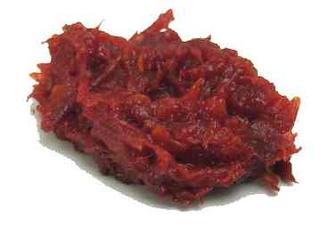
Ever wonder when you goto your favorite "Pho" restaurant what are the condiments on the table in front of you are?
There is likely to be a big fat squeeze bottle of Huy Fong Sriracha HOT Chili Sauce on every table. You may have contemplated this de facto centerpiece, embellished with snappy slogans in five languages, the white lettering seemingly printed right on the gleaming orange-red concoction under the clear plastic, all topped by a bright green dispenser cap. The overall effect is oddly Christmasy. The contents are loudly identified as tuong ot sriracha, but many adventuresome people can't get their mouths around that and simply call it "rooster sauce," after the proud bird on the label.

My favorite is the "Sambal Badjak". Badjak is one of the most commonly served of the Indonesian sambals and is usually made with candlenuts, which are hard to find in North America and can be substituted with macadamia nuts or cashews.
Badjak's spicy taste is enhanced with a hint of shrimp and onion. This flavorful mixture allows this sauce to be used in a variety of food dishes. It can be used as part of a dipping sauce for chips or as a marinade for meats and vegetables and especially for pho. :)
I can't seem to find badjak at Ranch 99. I know it's there somewhere in chinatown. The company Huy Fong doesn't make it anymore. As to why I don't know. At Cuu Long at Pearl Kai Shopping Center, I was told by one of the waitresses there that the owner makes his own big batch of badjak weekly or so.

If you never had the combination or sriracha, badjak, and hoisin together in your pho then you are definitely missing out. The trio combo is what rocks the house for me and my brother.
When we goto any vietnamese pho shop and there is no trio then either the shop ran out or they are just catering to the tourists. Which ultimately means their pho broth isn't good. If you see vietnamese people frequenting the shop you know they make a mean soup.
I plan to make my own sambal badjak sometime soon. I got my new trusty food processor ready to go.
Here is the recipe:
Hot Relish with Nuts (Sambal badjak)
Ingredients (Makes about 1 cup)
6 large fresh red chillies, roughly chopped
1 large onion6 cloves garlic
8 kemiri nuts, macadamia or cashew can be substituted, finely grated
3 tablespoons peanut oil
½ teaspoon laos powder
1 tablespoon dried shrimp paste (trasi)
1 teaspoon salt
5 tablespoons tamarind liquid
2 tablespoons palm sugar, or substitute
Put chillies, onion and garlic into a blender and blend to a pulp. It may be necessary to stop and start it to draw the onions and chillies down to the blades. When everything is bended smoothly, heat the oil in a small frying pan or saucepan and fry the blended mixture over low heat, stirring, for 5 minutes or until well cooked but not brown.
Add kemiri nuts, laos, trasi and salt.
Crush the trasi against the side of the pan and fry, stirring, until mixture
is well blended.
Add tamarind liquid and sugar, stir and simmer until well fried and reddish brown in color and the oil separates from the mixture.
Cool, do not serve sambal hot.
Stored in the refrigerator in a closed jam jar this can be kept for several weeks.


No comments:
Post a Comment